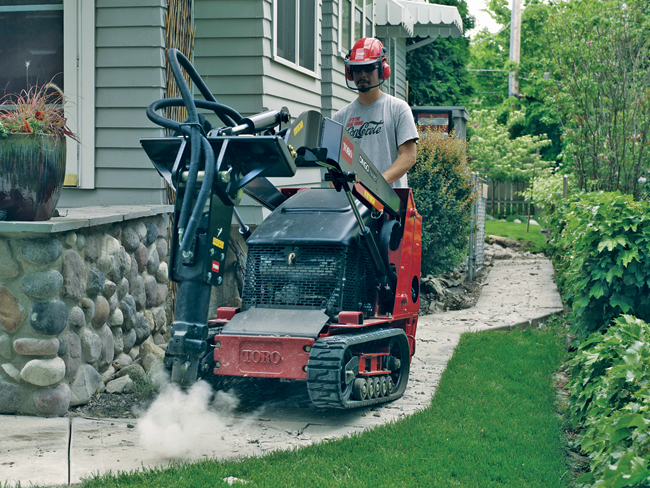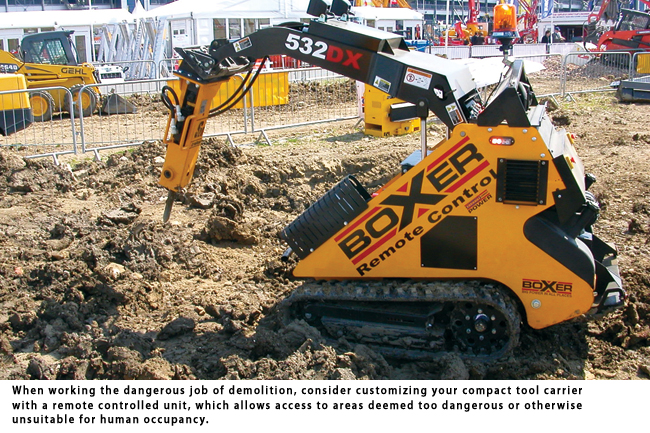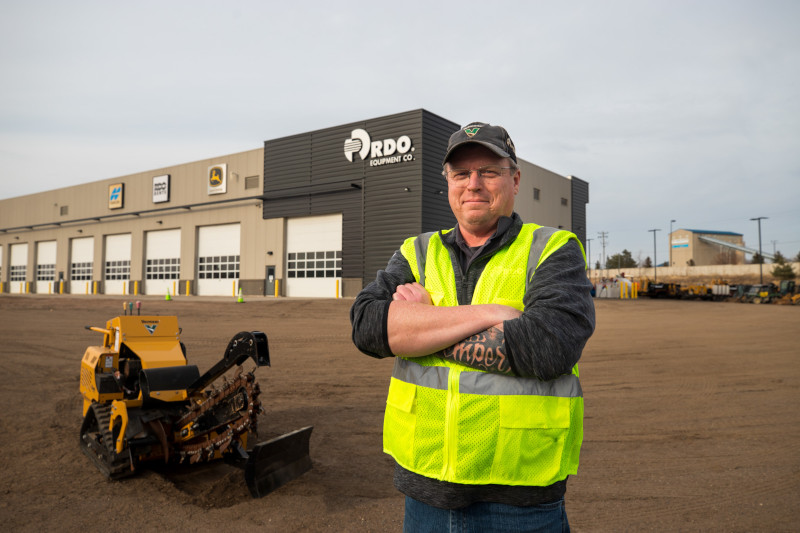Hammer Time
Compact tool carriers (CTCs) — also known as mini skid steers or compact utility loaders, depending on the brand — make big jobs in small places easy. Fitted with tracks or wheels and equipped with steel arms wielding a variety of hydraulic work tools (augers, trenchers, brooms, snow blowers and onward), CTCs can squeeze into cramped spaces and muscle jobs where bigger machines just can’t fit. Equip a CTC with a breaker or hammer attachment and you have diminutive demolition crew.
“Unlike larger breakers, a compact tool carrier equipped with a hydraulic breaker can work effectively in tight or confined spaces, eliminating time-consuming manual labor,” says Greg Lawrence, marketing product manager at The Toro Co., which offers six models of its red compact utility loader brand “The attachment even can be used horizontally to demolish walls. By clearing sight lines to all moving parts of the attachment, users have precise control and operation to complete jobs quickly and efficiently.”

When it comes to hammer or breaker attachments (same thing, different words), there are many options for compact tool carriers. The three main alternatives are mounted hydraulic breakers, mounted drop hammers and handheld hydraulic breakers. The most popular are the traditional mounted hydraulic breakers, which are attached via the CTC’s quick-attach plate and can be used in heavy-duty applications where both vertical and horizontal breaking may be required such as road work, demolition, electric utilities, rental, railroad, concrete and site prep and destruction.
Like all breakers, these CTC-mounted units are rated by impact energy in ft-lbs, ranging from 150 to 300 ft-lbs. The higher the class of the breaker, the more flow and pressure will be required from the hydraulic system. Concrete breakers are also measured in blows per minute (bpm). A typical CTC hammer will deliver 175 ft-lbs of force, using 1,200 bpm to break materials to a depth of 11 in. The breakers run off the unit’s hydraulic system, usually with flow ranges from 4 to 10 gpm or 9 to 16 gpm to hammer away on the jobsite, ranging in cost from $6,000 to $11,000.
“Standard hammers are used in heavy-duty applications where access is not restricted and concrete thickness or quantity requires a mounted tool approach,” explains Mark Myrick, international sales manager for Boxer, which offers eight models of CTCs. “We also offer handheld hydraulic breakers, which are used in light- to medium-duty applications where larger mounted breakers will not work or where precise demolition is needed.”
While the hydraulic flow and pressure from most CTCs are too high to correctly operate handheld breakers, manufactures like Stanley Black and Decker offer options to safely and efficiently operate the tools. These brands offer a hydraulic converter that takes the power from the hydraulic system of various CTCs and converts it into the flow and pressure acceptable for hand held hydraulic breakers use 7-9 gpm at 2,000 psi (138 bar). The handheld breaker price range is usually between $1,500 and $2,500.
Rounding out the options, bigger and more powerful CTC’s can operate drop hammers, specifically developed for the demolition and recycling industries to quickly breakup large volumes of concrete. While the mounted breakers can be used in both the vertical and horizontal positions, the drop hammer is only used in the vertical position. A mounted breaker has a tendency to break concrete into smaller pieces, but the drop hammer pulverizes concrete and breaks up larger areas with each impact.
“The hydraulics from the compact tool carrier lifts a weight via a catch and a chain drive,” explains Myrick. “When the chain rotates over the top, the catch falls and releases the weight. The hammer is allowed to free fall and impact the ground surface. An average impact produces 1,500 ft-lbs of energy with a 32 blow per minute frequency, creating numerous fractures per impact.”
Get to Work
Hydraulic breakers simplify the tough job of breaking concrete, asphalt, rock or brick. On a CTC, they’re ideal for breaking up footings, sidewalks, foundations and other solid structures — if the unit is properly outfitted. For example, CTCs with tracks are often better than wheels in demolition applications.
“Demolition jobsites are full of metal and sharp concrete blocks, so wheeled units will get flats all the time,” says Myrick.
Certain CTC models offer a variety of safety features, both standard and optional, that are worth investigating. If your unit does not come with a metal hood, a hood protector is a smart investment to protect your machine’s engine from falling objects. It’s also nice to have a unit with self-centering controls, which automatically return the ground drive to neutral and disengage the attachments the moment you leave the machine’s controls. Safety bars and operator presence switches are also equally as important.
When choosing a specific breaker, consider different chisel points, moil points and asphalt cutters to customize for your work conditions. By adding various dedicated chisel or moil points, an operator can handle specific jobsites with the best possible break point for the project. When using the breaker, careful operation is imperative. When positioning a CTC breaker vertically, lower it until it reaches its point of contact. Then the hydraulics should be activated and the breaker is ready to operate. Never operate the breaker without pressure on the tool. This is called dry firing and can damage the breaker housing, the tool or the CTC.
“When breaking the material, work in small sections — start at the edge of the material and work toward the center,” says Lawrence. “Attempting to break too much material at once can cause the bit to get stuck and cause damage to the breaker house. Also, do not use the breaker to pry material. If the breaker does get stuck, do not use the drive system’s hydraulics to release it. This action can lead to damage to the housing, tool or the unit itself.”
Every construction site offers varying degrees of hazard and each jobsite is unique. For instance, indoor or difficult-to-access jobsites are not uncommon, so adapt your unit for the application. “Several Boxer customers have converted their compact tool carriers into electric drive, remote controlled units to allow access to areas deemed too dangerous or otherwise unsuitable for human occupancy,” says Myrick. “A remote controlled unit is often needed in demolition environments due to health and safety concerns.”
Due to the complexity of a demolition contract and the multiple functions required to complete the project, a multi-functional CTC can also reduce downtime using complimentary attachments. A classic example is removing the hydraulic breaker to bring in a bucket to remove the debris. Just remember to choose the right unit for the job — one that provides good visibility and the right amount of power. You should always be aware of everything going on around the perimeter of your machine while working and know the limitations of your machine and its attachments. Take time to get familiar with your CTC before you take it out to the site and wear proper work attire. Operating limitations are clearly spelled out in your manual, which you should read and comprehend thoroughly before starting.
“Read the operators manual if you are not sure how to operate a hammer,” says Jon Kuyers, product manager of utility products for Vermeer, which offers four units in its Mini Skid Steer brand. “Damage can be caused to the breaker if it is engaged and not impacting the material. And always use a hard hat, hearing and eye protection in a demolition application.”
Keith Gribbins is managing editor of Compact Equipment, based in Peninsula, Ohio.





Comments are closed here.